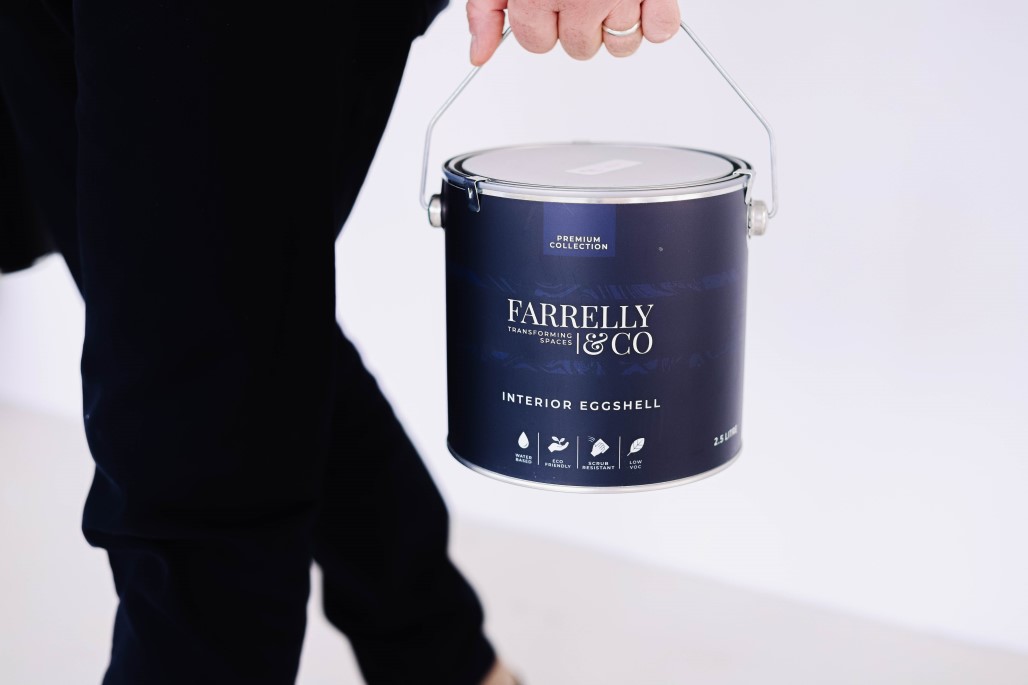A Step-By-Step Guide on How to Paint a Wall Like a Pro

The Tools You Need to Paint a Wall
- Paint - Choose the right finish and colour of paint for your project. You can explore our wide range here.
- Paint brushes and Rollers - High-quality brushes and rollers make a significant difference in the finish. Invest in a selection of brushes and rollers for different surfaces.
- Drop Cloths - Protect your floors and furniture from accidental paint spills by laying down drop cloths.
- Painter's Tape - Use painter's tape to mask off areas you don't want to paint, like trims and edges.
- Primer - (unless you're using Farrelly & Co paint that is. In the main, our paints don't require the use of primer)
- Filler for imperfections - we like to use Toupret Wood Filler for all woodwork and Toupret Joint & Skim for walls.
- Sandpaper - Smooth out any rough patches or imperfections on the wall with sandpaper.
- Paint Tray - Pour your paint into a paint tray for easy access
- Stir Sticks and Paint Can Opener - Ensure your paint is well-mixed before starting, and use a can opener to access the paint cans.
- Extension Poles - For high walls or ceilings, extension poles are handy for reaching those challenging spots.Now that you've assembled your tools, it's time to prepare your wall for the painting process.

How to Prep Your Wall for Painting
Preparation is the key to achieving a professional-looking paint job. Follow these steps to get your wall ready for a fresh coat of paint:
1. Clear the Space - Remove furniture from the room or move it to the centre, covering it with drop cloths to protect it from paint splatter.
2. Clean the Wall - Wipe down the wall to remove any dust, dirt, or grease. A clean surface ensures the paint adheres properly.
3. Repair Imperfections - Fill in any holes or cracks. Once dry, sand the patched areas for a smooth finish.
4. Apply Painter's Tape - Use painter's tape to mask off any areas you want to keep paint-free, such as baseboards, trim, and light switches.
Now that your wall is prepped and ready, let's dive into the painting process.
How to Paint a Wall: Painting Instructions
With your wall prepared, it's time to pick up your paintbrush and start transforming your space. Here's a step-by-step guide to painting a wall:
1. Cut in the Edges - Begin by "cutting in" around the edges of the wall using a brush. Paint a border around the top and bottom of the wall, as well as around any corners or edges.
2. Roll on the Paint - After cutting in, use a roller to apply paint to the main surface of the wall. Work in small sections, using a "W" or "N" pattern to ensure even coverage.
3. Blend the Sections - While the paint is still wet, blend the sections you've painted with the roller to avoid visible lines or streaks.
4. Multiple Coats - Depending on the colour and your desired finish, you may need to apply two or more coats of paint. Allow each coat to dry completely before applying the next.
5. Remove Painter's Tape - Remove the painter's tape while the paint is still slightly damp to ensure clean edges.
6. Clean Up - Clean your brushes, rollers, and any other tools promptly to prevent the paint from drying and becoming difficult to remove.
What to Watch Out For
As you embark on your wall-painting project, keep an eye out for a few common issues:
- Drips and Runs - Be cautious not to overload your roller with paint to avoid drips and runs.
- Uneven Coverage - Ensure that you apply the paint evenly and blend it properly for a consistent finish.
- Visible Brush Strokes - Brush strokes can be minimised with the right technique and using high-quality brushes.
- Paint Splatter - Keep your paint strokes controlled to prevent splattering on nearby surfaces.
With these tips in mind, you're well on your way to painting your wall like a pro. If you have any questions or need further assistance, feel free to get in touch with us through our contact page or book our services via our booking form.
Painting a wall can be a satisfying and transformative DIY project, and with the right tools and preparation, you can achieve a professional finish that enhances your living space. Happy painting!


 Browns
Browns
 Blues
Blues
 All Colours
All Colours






